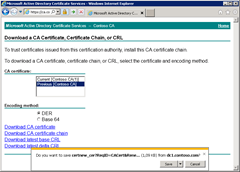Posts on this page:
- CA certificates and Untrusted Certificates container
- How to change CA certificate validity period
- How to remove expired user certificates from Active Directory
- You cannot download CA certificate from web enrollment pages
- Get registered CNG CSPs on the system
As you may know a DigiNotar CAs was compromised due of some reasons (one, two). Microsoft have decided to break DigiNotar CAs trust at all — http://support.microsoft.com/kb/2607712. Trust breaking is performed as follows:
- DigiNotar CA certificates are removed from Windows Update;
- DigiNotar CA certificates are removed from crypt32.dll on Windows Vista+;
- DigiNotar CA certificates are moved from Trusted Root CAs container to Untrusted Certificates.
Read more →
Today I want to discuss one question about CA certificate validity and how this can be changed.
Issue background
A little abstract. When you install Windows Certification Authority the default value is 5 years. It is quite long period and many young administrators leave default value (especially if they are not very experienced in certificate services). After a time it appears that 5 years is too short validity for CA certificate and administrators lookups for a resolution.
Read more →
Hi S-1-1-0! Today I would like to talk about one of the most requested case — expired user certificate removal from Active Directory.
By default when user requests an authentication and/or encryption certificate from an Enterprise CA it is published to userCertificate property under user account in Active Directory. Published authentication certificate is used for certificate mapping to a user account (or group) and are used by domain controllers during certificate-based authentication. Encryption certificates can be used to provide an access to certain encrypted content. In the case of secure email, sender retrieves recipient's certificate from Active Directory and uses it for mail message encryption purposes. The same process occurs when a user want to provide an access to encrypted file (EFS) for another user. Retrieved certificate is used to re-encrypt symmetric encryption key material.
The negative side here is that certificates sometime expires. If existing certificate is renewed it is added to the userCertificate attribute and expired certificates are not replaced. Certain applications can filter expired certificates and display/select only valid certificates. However other applications may not. In the large environments expired certificates increases Active Directory replication traffic. As the result certain companies performs sanity certificate cleanup on a regular basis. The question here — how can I do this? Lets explore some background and solutions.
Read more →
SYMPTOMS
When you try to download CA certificate from web enrollment pages you get a prompt message with unreadable proposed file name:
Do you want to save certnew_cer?ReqID=CACert&Renewal=1&Enc=bin (1,09 KB) from <ServerName>
Read more →
Some time ago I've posted a simple code example that will retrieve registered CSPs: Get registered CSPs on the system. The code was updated to provide detailed information about supported algorithms and protocols by particular CSP. Updated version of this code is shipped with my PowerShell PKI module as a Get-CryptographicServiceProvider cmdlet. The output is pretty informative:
Read more →




